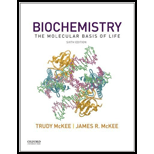
Toanalyze:
The free energy changes occurring in the two reactions.
Introduction:
Gibbs free energy is the change in free energy, which is involved in
Explanation of Solution
The free energy changes (∆G°) in the given reactions can be calculated using the following procedure:
In this reaction, the electron acceptor is O2 and the electron donor is NADH. The number of electrons transferred is 2. The reduction potential for O2 is 0.815V and for NADH it is -0.32V.
Substituting the values of reduction potential for S and NADH.
Therefore, it can be concluded that Gibbs free energy for both the reactionsis negative, which implies that these are exergonic as well as spontaneous reactions. In exergonic reactions, energy is released.
Want to see more full solutions like this?
Chapter 9 Solutions
BIOCHEMISTRY:MOLECULAR...-W/ACCESS
- what is the importance of the first law of thermodynamics in biological systems, especially living organisms?arrow_forwardUnder what conditions is the entropy H(X) equal to zero?arrow_forwardThis is a plot under standard conditions of free energy corresponding to a chemical reaction of A+B to C+D. What will happen if only C+D are present under standard temperature and pressure? Please explain why.arrow_forward
 BiochemistryBiochemistryISBN:9781319114671Author:Lubert Stryer, Jeremy M. Berg, John L. Tymoczko, Gregory J. Gatto Jr.Publisher:W. H. Freeman
BiochemistryBiochemistryISBN:9781319114671Author:Lubert Stryer, Jeremy M. Berg, John L. Tymoczko, Gregory J. Gatto Jr.Publisher:W. H. Freeman Lehninger Principles of BiochemistryBiochemistryISBN:9781464126116Author:David L. Nelson, Michael M. CoxPublisher:W. H. Freeman
Lehninger Principles of BiochemistryBiochemistryISBN:9781464126116Author:David L. Nelson, Michael M. CoxPublisher:W. H. Freeman Fundamentals of Biochemistry: Life at the Molecul...BiochemistryISBN:9781118918401Author:Donald Voet, Judith G. Voet, Charlotte W. PrattPublisher:WILEY
Fundamentals of Biochemistry: Life at the Molecul...BiochemistryISBN:9781118918401Author:Donald Voet, Judith G. Voet, Charlotte W. PrattPublisher:WILEY BiochemistryBiochemistryISBN:9781305961135Author:Mary K. Campbell, Shawn O. Farrell, Owen M. McDougalPublisher:Cengage Learning
BiochemistryBiochemistryISBN:9781305961135Author:Mary K. Campbell, Shawn O. Farrell, Owen M. McDougalPublisher:Cengage Learning BiochemistryBiochemistryISBN:9781305577206Author:Reginald H. Garrett, Charles M. GrishamPublisher:Cengage Learning
BiochemistryBiochemistryISBN:9781305577206Author:Reginald H. Garrett, Charles M. GrishamPublisher:Cengage Learning Fundamentals of General, Organic, and Biological ...BiochemistryISBN:9780134015187Author:John E. McMurry, David S. Ballantine, Carl A. Hoeger, Virginia E. PetersonPublisher:PEARSON
Fundamentals of General, Organic, and Biological ...BiochemistryISBN:9780134015187Author:John E. McMurry, David S. Ballantine, Carl A. Hoeger, Virginia E. PetersonPublisher:PEARSON





